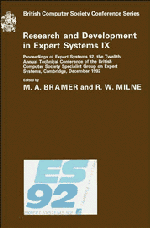Book contents
- Frontmatter
- Contents
- Preface
- Introduction
- CONSULTANT: providing advice for the machine learning toolbox
- A methods model for the integration of KBS and conventional information technology
- KBS methodology as a framework for co-operative working
- Project management for the evolutionary development of expert systems
- The specification and development of rule-based expert systems
- Towards a method for multi-agent system design
- Jigsaw: configuring knowledge acquisition tools
- On the relationship between repertory grid and term subsumption knowledge structures: theory practice tools
- Strategy maze: an on-line tool for support management of the knowledge acquisition process
- Concurrent engineering using collaborating truth maintenance systems
- Ockham's razor as a gardening tool
- A designer's consultant
- Fairness of attribute selection in probabilistic induction
- An application of case-based expert system technology to dynamic job-shop scheduling
- Neural network design via LP
- KEshell2: an intelligent learning data base system
- Approaches to self-explanation and system visibility in the context of application tasks
- An object oriented approach to distributed problem solving
- Intelligent user interface for multiple application systems
- Combining qualitative and quantitative information for temporal reasoning
- Documents as expert systems
KEshell2: an intelligent learning data base system
Published online by Cambridge University Press: 04 August 2010
- Frontmatter
- Contents
- Preface
- Introduction
- CONSULTANT: providing advice for the machine learning toolbox
- A methods model for the integration of KBS and conventional information technology
- KBS methodology as a framework for co-operative working
- Project management for the evolutionary development of expert systems
- The specification and development of rule-based expert systems
- Towards a method for multi-agent system design
- Jigsaw: configuring knowledge acquisition tools
- On the relationship between repertory grid and term subsumption knowledge structures: theory practice tools
- Strategy maze: an on-line tool for support management of the knowledge acquisition process
- Concurrent engineering using collaborating truth maintenance systems
- Ockham's razor as a gardening tool
- A designer's consultant
- Fairness of attribute selection in probabilistic induction
- An application of case-based expert system technology to dynamic job-shop scheduling
- Neural network design via LP
- KEshell2: an intelligent learning data base system
- Approaches to self-explanation and system visibility in the context of application tasks
- An object oriented approach to distributed problem solving
- Intelligent user interface for multiple application systems
- Combining qualitative and quantitative information for temporal reasoning
- Documents as expert systems
Summary
Abstract
An intelligent learning data base (ILDB) system is an integrated learning system which implements automatic knowledge acquisition from data bases by providing formalisms for 1) translation of standard data base information into a form suitable for use by its induction engines. 2) using induction techniques to produce knowledge from data bases, and 3) interpreting the knowledge produced efficiently to solve users' problems. Although a lot of work on knowledge acquisition from data bases has been done, the requirements for building practical learning systems to learn from conventional data bases are still far away for existing systems to reach. A crucial requirement is more efficient learning algorithms as realistic data bases are usually fairly large. Based on KEshell. dBASE3 and the low-order polynomial induction algorithm HCV. this paper presents a knowledge engineering shell. KEsheH2. which implements the 3 phases of automatic knowledge acquisition from data bases in an integral way.
INTRODUCTION
Over the past twenty years data base research has evolved technologies that are now widely used in almost every computing and scientific field. However, many new advanced applications including computer-aided design (CAD), computer-aided manufacturing (CAM), computer-aided software engineering (CASE), image processing, and office automation (OA) have revealed that traditional data base management systems (DBMSs) are inadequate, especially on the following cases [Wu 90b]:
Conventional data base technology has laid particular stress on dealing with large amounts of persistent and highly structured data efficiently and using transactions for concurrency control and recovery.
[…]
- Type
- Chapter
- Information
- Research and Development in Expert Systems IX , pp. 253 - 272Publisher: Cambridge University PressPrint publication year: 1993
- 1
- Cited by

